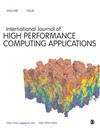EXAGRAPH: Graph and combinatorial methods for enabling exascale applications
IF 2.5
3区 计算机科学
Q2 COMPUTER SCIENCE, HARDWARE & ARCHITECTURE
International Journal of High Performance Computing Applications
Pub Date : 2021-09-30
DOI:10.1177/10943420211029299
引用次数: 11
Abstract
Combinatorial algorithms in general and graph algorithms in particular play a critical enabling role in numerous scientific applications. However, the irregular memory access nature of these algorithms makes them one of the hardest algorithmic kernels to implement on parallel systems. With tens of billions of hardware threads and deep memory hierarchies, the exascale computing systems in particular pose extreme challenges in scaling graph algorithms. The codesign center on combinatorial algorithms, ExaGraph, was established to design and develop methods and techniques for efficient implementation of key combinatorial (graph) algorithms chosen from a diverse set of exascale applications. Algebraic and combinatorial methods have a complementary role in the advancement of computational science and engineering, including playing an enabling role on each other. In this paper, we survey the algorithmic and software development activities performed under the auspices of ExaGraph from both a combinatorial and an algebraic perspective. In particular, we detail our recent efforts in porting the algorithms to manycore accelerator (GPU) architectures. We also provide a brief survey of the applications that have benefited from the scalable implementations of different combinatorial algorithms to enable scientific discovery at scale. We believe that several applications will benefit from the algorithmic and software tools developed by the ExaGraph team.EXAGRAPH:启用exascale应用程序的图形和组合方法
一般的组合算法,特别是图算法在许多科学应用中发挥着关键的作用。然而,这些算法的不规则内存访问特性使它们成为最难在并行系统上实现的算法内核之一。凭借数百亿的硬件线程和深度内存层次结构,exascale计算系统尤其对缩放图算法提出了极大的挑战。组合算法的代码设计中心ExaGraph的成立是为了设计和开发有效实现从一组不同的exascale应用程序中选择的关键组合(图)算法的方法和技术。代数方法和组合方法在计算科学和工程的发展中具有互补作用,包括相互发挥促进作用。在本文中,我们从组合和代数的角度考察了ExaGraph主持下进行的算法和软件开发活动。特别是,我们详细介绍了我们最近在将算法移植到多核加速器(GPU)架构方面所做的努力。我们还简要介绍了受益于不同组合算法的可扩展实现的应用程序,以实现大规模的科学发现。我们相信,ExaGraph团队开发的算法和软件工具将使一些应用程序受益。
本文章由计算机程序翻译,如有差异,请以英文原文为准。
求助全文
约1分钟内获得全文
求助全文
来源期刊
CiteScore
6.10
自引率
6.50%
发文量
32
审稿时长
>12 weeks
期刊介绍:
With ever increasing pressure for health services in all countries to meet rising demands, improve their quality and efficiency, and to be more accountable; the need for rigorous research and policy analysis has never been greater. The Journal of Health Services Research & Policy presents the latest scientific research, insightful overviews and reflections on underlying issues, and innovative, thought provoking contributions from leading academics and policy-makers. It provides ideas and hope for solving dilemmas that confront all countries.

 求助内容:
求助内容: 应助结果提醒方式:
应助结果提醒方式:


